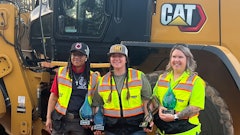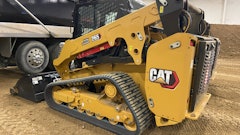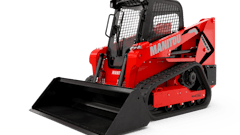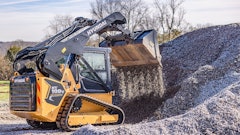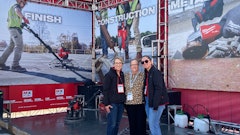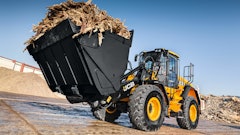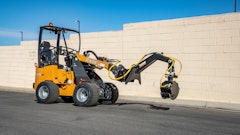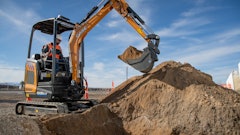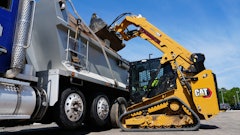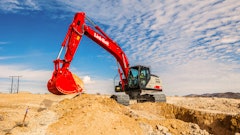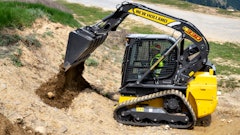A 299D3 with semi-autonomous load and haul capability made its debut in the latest equipment challenge from Caterpillar: Cat Trial 12: No Hands. In this video we break down how the new tech layer works with the existing Cat® Command™ Remote Control platform and how it will impact safety, productivity, and efficiency.
For a while now—at least since the advent of grade control—the promise of machine automation has hung over the construction industry. To some it holds the possibility of increased production efficiencies, or a badly-needed solution to the ever-shrinking pool of skilled labor, or, and most importantly, safer jobsites.
And while others in the industry are a bit more skeptical of the technology and its impact, it’s clear that automation, in some form or fashion will have a large part to play in the future of construction.
Robotics has and continues to play a huge role in the manufacturing industry and is now poised to gain foothold in other industries such as hospitality and restaurants heretofore unaffected by serious labor shortages.
In fact, Cat has heard from customers that semi-autonomous equipment is actually expanding the labor pool, allowing people to work with equipment that might not be otherwise able.
Why a semi-autonomous CTL now?
There are several factors—both internal and external to the construction industry—to credit with automation’s pace. For starters, there’s the huge growth we’ve seen in the last decade in terms of consumer comfort with technology, and—of course—the billions being spent by the automotive industry to make fully self-driving cars a reality.
And if you want to know just how real the move toward automation has gotten in construction, look no further than Caterpillar, who recently gave me the opportunity to get an early look at its very first semi-autonomous compact machine: a 299 D3 with a new autonomous layer atop the established Cat Command remote control technology.
Co-starring with a Cat 794 AC electric drive autonomous mine truck, this machine made its official debut in the latest Cat Trial video: “No Hands.” If you haven’t seen that already, be sure to check it out by clicking here.
How the semi-autonomous 299D3 CTL works
So, I think the first thing you need to know is that Cat didn’t develop a whole new machine. Just a brain…and eyes.
This brain is an add-on roof rack similar to the Cat Command module the company announced in January of this year that enables remote control for its D3 CTL models. So, everything, all the hardware like LIDAR and cameras for this machine to see and make sense of the world around it, is contained right up here.
Cat says it requires almost no mods to the base machine to be installed, and can attach in less than a day.
And given where we’re at in terms of the evolution of autonomous equipment, this pin-on roof rack is a pretty smart solution on Caterpillar’s part.
Rather than build specific models equipped with integrated autonomy, something that Cat says a fraction of a fraction of its customer base are actively interested in buying today, this is a non-destructive, easy to install, easy to remove solution for delivering the technology precisely to the customers and between the machines where it’s needed.
I mentioned earlier that the autonomous hardware you see here is based heavily on the Cat Command remote control kit. In fact, Cat says that this hardware allows customers to remove or add layers of technology as needed.
At the foundation is a D3 series CTL that an operator can hop inside of and operate like normal. Add on the roof rack though and you can enable remote control. From there you can add the final layer of full automation.
In other words, the machine is basically a host. It has no idea it’s an “autonomous” machine. It’s just looking for input and that input can come from operator, control pack, and now a design file and the brain inside this roof rack.
3 key things that made an autonomous CTL possible
This autonomy package is decades in the making, made possible by three key moves within Caterpillar.
The first is the wealth of knowledge the company has amassed in the research and development of autonomous haul trucks for mining. The history of Cat autonomous mining trucks stretches all the way back to 1996 when the company unveiled the first autonomous haul truck at MINExpo.
In 2013 the company deployed the first six trucks to the field and in the 9 years since then, the fleet has grown to more than 500 autonomous trucks traveling mine sites across the world, piling up 4 billion tons of material moved and more than 90 million miles traveled.
The next key development within Cat happened about 10 years ago when the decision was handed down to overhaul the electrical architecture within Cat machines.
Thanks to this progressive and modular wiring harness at the heart of modern Cat machines, plugging in the autonomous brain is as simple as a single connector.
The most recent move making this technology possible was Cat’s June 2020 acquisition of Marble Robot, a San Francisco-based start-up focused on the development of delivery robots capable of navigating urban environments.
Like those food delivery robots, for this first machine, Cat has focused on simple operation in complex environments—like load and carry in solar farm construction.
Note the mention of complex environments. Though Cat had tons of experience automating massive mining trucks, those trucks are traveling roads on mine sites with restricted, highly controlled access. A CTL needs to be able to safely traverse a job site full of people on foot, along with other machines and small vehicles coming in and out.
So even though Marble’s initial focus could not have been further removed from construction, its automation tech’s ability to navigate busy urban areas was a key addition that enabled Caterpillar machines to navigate a working job site safely using a combination of LIDAR, cameras and ultra sonic sensors.
The pin-on Cat Command module on top of the CTL has 360-degrees of LIDAR and camera perception, allowing it to “see” and avoid objects and people.
So, when can you expect to see autonomous CTLs roving jobsites? The “brain” atop this particular 299 D3 is a working prototype that apart from starring in Cat promotional videos is in testing on select customer jobsites. Cat isn’t saying just yet when they will bring the technology to market.







